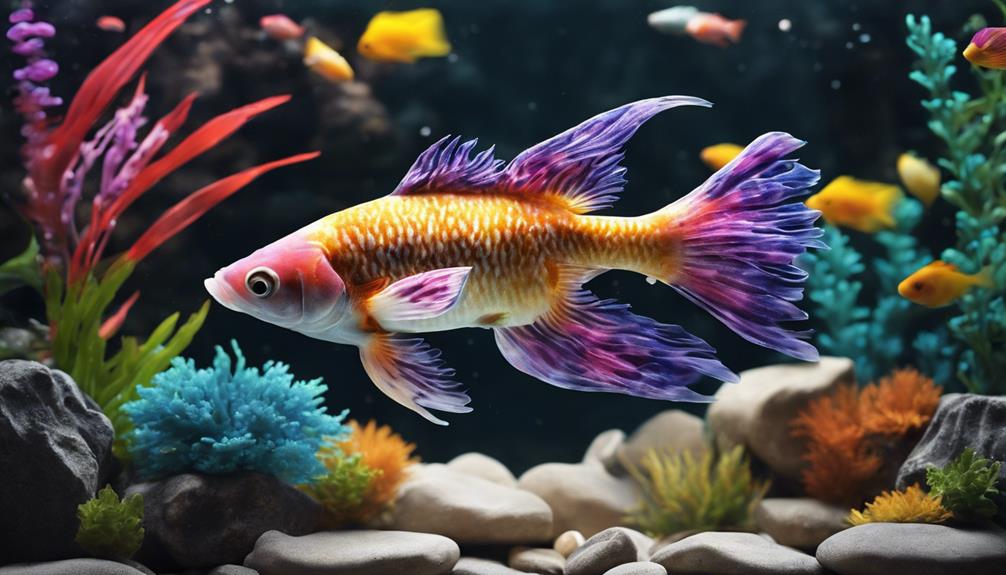If your fish are **swimming erratically** or **hiding constantly**, it may indicate illness or aggression from other fish in the tank. Observing their behavior and appearance can help catch problems early. Offering good food, keeping water quality in check, and **consulting a vet** who knows about aquatic animals can help figure out and fix any health issues. By being vigilant about your fish’s health and making a happy space for them, you can have a lively fish tank community. Dive deeper into your fish’s world and take the best care of them.
Key Takeaways
- Stress or discomfort from environmental changes
- Inadequate hiding spots causing insecurity
- Potential health issues leading to lethargy
- Hunger levels and anticipation of food
- Social dynamics and territorial behaviors
Behavioral Factors
In studying the behavioral factors influencing fish immobility, it becomes apparent that stillness often signifies underlying stress or discomfort within their environment. Fish, being highly sensitive creatures, exhibit their emotions through their behavior. When a fish stays in one spot in the tank, it could be an indication of stress caused by changes in water quality, tank setup, or interactions with other tank mates. Understanding the reasons behind this behavior is crucial for maintaining the well-being of our aquatic companions.
Stress from the tank environment or interactions with other fish can lead to a fish choosing to remain stationary. It's essential to observe their behavior closely to identify any signs of distress promptly. By addressing stress factors and creating a harmonious environment, we can help prevent our fish from feeling the need to stay in one spot.
Paying attention to their behavior and ensuring a comfortable and stable environment is key to promoting the overall health and happiness of our fish.
Tank Environment

Considering the impact of the tank environment on fish behavior, the presence or absence of adequate hiding spots can significantly influence their tendency to stay in one spot. Fish require a sense of security and safety to thrive in their surroundings.
Here are three crucial aspects to ponder:
- Tank Size: Smaller tanks can lead to increased stress and inactivity among fish, making them more likely to remain stationary.
- Inadequate Hiding Spots: The lack of hiding places can cause fish to feel insecure, resulting in prolonged periods of inactivity.
- Hiding Options: Providing various hiding options such as caves with stones or driftwood can help fish feel secure and encourage natural movement patterns.
To create a comfortable environment for your fish, consider incorporating natural plants into the tank. These additions not only enhance the aesthetics of the tank but also offer hiding spots and stimulation for the fish, reducing the tendency to stay in one spot.
Health Concerns
Observing a fish's behavior in staying in one spot can provide valuable insights into potential health concerns that may be affecting its well-being. Illness is a common reason for fish to exhibit such behavior, often accompanied by symptoms like lethargy, loss of appetite, and the presence of excess body mucus. When fish display these signs, consulting a veterinarian is essential to diagnose the underlying issue and determine the appropriate treatment. Different diseases can manifest in various ways, making early detection crucial for effective intervention.
To prevent the spread of illnesses to other tank inhabitants, setting up a separate quarantine tank for sick fish is recommended. Regular observation of fish for any changes in behavior or physical appearance can aid in spotting health issues promptly. By maintaining a vigilant eye on our fish and seeking professional help when needed, we can ensure their well-being and address any health concerns that may be causing them to stay in one spot.
Feeding Habits

When assessing the feeding habits of fish, it becomes evident that their behavior can be influenced by various factors, including hunger levels and dietary routines.
- Anticipation: Fish will often exhibit signs of anticipation when they're hungry and awaiting food. This behavior can lead them to stay in one spot, eagerly waiting for their next meal.
- Overfeeding and Digestive Issues: Overfeeding can cause discomfort and digestive problems in fish, leading them to stay still in one spot due to these issues. It's essential to provide appropriate portions to avoid this situation.
- Scavenging and Feeding Schedule: If there's uneaten food in the tank, fish may linger in one area to scavenge for leftovers. Establishing a regular feeding schedule not only prevents hunger-induced stillness but also encourages active behavior in fish.
Providing a balanced diet with appropriate portions is crucial for maintaining the health and activity levels of your aquatic pets.
Social Dynamics

Within an aquarium setting, fish social dynamics play a crucial role in shaping behaviors and interactions among aquatic inhabitants. Understanding the hierarchy and territorial behavior that can arise among fish species is essential for maintaining a harmonious environment in the tank. Aggressive fish may stake out territories, causing other more timid fish to stay in one spot out of fear. Schooling fish, on the other hand, often stick together in one area for safety and companionship.
| Social Dynamics | Explanation |
|---|---|
| Hierarchy | Dominant fish may control certain areas, influencing the movement and behavior of other tank mates. |
| Territorial Behavior | Fish can exhibit territorial behavior, defending a specific area within the tank from intruders. |
| Schooling Fish | Species that prefer schooling behavior tend to stay close together, providing a sense of security and safety. |
| New Fish Introduction | Introducing new fish can disrupt existing social dynamics, leading to stress and potential conflicts. |
| Harmonious Environment | Understanding the social behavior of different fish species helps create a balanced and peaceful tank environment. |
Frequently Asked Questions
Why Is My Fish Just Staying in One Spot?
We've noticed that fish staying in one spot could be a sign of stress, illness, or a lack of hiding spots. Factors like power outages, habitat changes, or fear of prey may also contribute.
Behavioral issues, such as environmental changes or stress from tank mates, can keep fish still. It's important to address these issues by testing water parameters, providing hiding spots, and creating a stress-free environment. This can help prevent fish from staying in one spot.
Why Is My Fish Sitting in One Spot Has Not Moved and Not Eating?
We observe that our fish is sitting in one spot, not moving, and not eating. This behavior indicates potential health issues or stress. Factors such as water quality, tank mates, and environmental changes can contribute to this behavior.
Monitoring water parameters, observing fish closely, and seeking veterinary advice are essential steps. Ensuring a stress-free environment and providing proper nutrition are crucial for the well-being of our fish.
Do Fish Stay in the Same Area?
Fish do stay in the same area for various reasons. This behavior can be influenced by stress, environmental changes, tank mates, illness, or a lack of hiding spots. They might also seek safety near filters for oxygen or food.
Behavioral factors like aggression, breeding, or hunger can contribute to fish staying in one spot. Monitoring and addressing these factors can help prevent fish from remaining still, ensuring their well-being and activity levels.
Why Is My Fish Hiding and Not Moving?
We've noticed that fish may hide and remain still due to various factors, such as stress from environmental changes, illness, or feeling insecure in a new tank. It's crucial to monitor water quality, tank setup, and fish behavior to address these issues.
Providing hiding spots, proper tank size, and suitable tank mates can help reduce this behavior. Observing closely and making necessary adjustments can promote a healthy and active fish environment.
How Can I Keep My Fish from Just Staying in One Spot at Home?
To prevent your fish from just staying in one spot at home, ensure they have enough space to swim freely. Also, create an environment with hiding spots and vegetation to keep them active. Proper feeding and water quality are key to keeping sucker fish thriving.
Conclusion
After analyzing the behavioral factors, tank environment, health concerns, feeding habits, and social dynamics of our fish, we can conclude that there are multiple reasons why they may stay in one spot.
However, the true answer may still elude us. As we continue to observe and study their behavior, we hope to uncover the mystery behind their stationary behavior.
Stay tuned for more updates on our fascinating aquatic friends.










